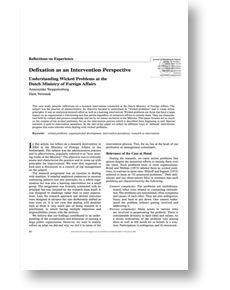International trade can make a huge difference towards sustainability, as over half of what is produced globally crosses national borders. Several of the United Nations 2030 Sustainable Development Goals – such as realizing ‘zero hunger’ and ‘no poverty’, ensuring all have ‘decent work’, and taking ‘climate action’ – crucially depend on transforming the way international trade is organized. But international value chains are complicated, involving many different people working in diverse contexts that change over time. Therefore Read more…
publications
Collaborative transformation
The art of making international trade more sustainable
Using causal loop diagrams to deal with complex issues
In: D. W. Jamieson, Barnett & A Buono (eds.) Consultation for Organizational Change Revisited - Information Age Publishing, 2016
A persistent stereotype of consultants is that of experts who have all the answers. However, the more complex problems are, the less consultants are able to provide ‘magical solutions’. Causal loop diagrams (CLDs) are a powerful tool to deal with issues characterized by content complexity and process complexity. Read more…
‘Defixation’ as an intervention perspective.
Understanding Wicked Problems at the Dutch Ministry of Foreign Affairs.
This case study presents reflections on a research intervention conducted at the Dutch Ministry of Foreign Affairs. The subject was the practice of administration. Its objective became to understand its “wicked problems” and to create action principles. It was an analytical research effort as well as a learning intervention. Read more…
Working interactively with causal loop diagrams
In: J. Boonstra, L. de Caluwé (eds.) Intervening and changing - Wiley, 2007
Causal loop diagrams can help in tackling complex issues effectively. Until the nineteen-seventies the literature focussed on the technique of such diagrams. Since then it has become evident that participation of stakeholders in making and applying such diagrams is desired to affect change. Read more…
Book summary ‘Enjoying tough issues’
Dynamics of innovation and stagnation
There is no shortage of tough issues: whether it is collaboration between professionals, external oriented government, sustainable economy or development cooperation. They are characterized by complexity of different kinds: many factors and many actors are involved. It makes tough issues hard to pin down and impossible to eradicate. The dominant change repertoires are ill equipped for tough issues: clear division of tasks and responsibilities, minimizing conflicts, drawing up organizational missions, rolling out large-scale change programs Read more…











